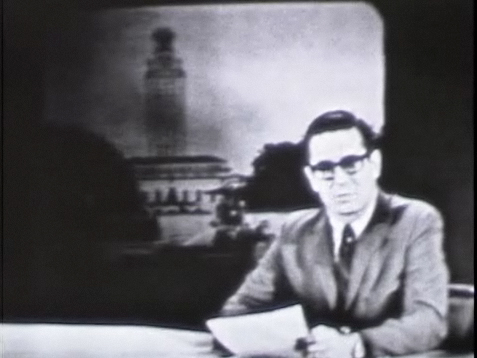TAMI Flashback: The University of Texas Tower Shootings

This article is the ninth in a Slackerwood series about the Texas Archive of the Moving Image (TAMI) video library.
August 1, 1966 may be the worst day in Austin history. On that day, 25-year-old University of Texas student Charles Whitman went on a shooting rampage from atop the university tower, killing three people inside the tower and 10 more on the ground below, and wounding 32 others. In the early morning hours before the shooting spree, Whitman also stabbed his mother and wife to death.
The horror of that day lives on in many Austinites' memories. Thanks to reporters and cameramen at Austin's KTBC-TV who covered the story at great personal risk, the horror also lives on in dramatic news footage of the tragedy.
The TAMI library includes several videos about Whitman's rampage. The best of them is Neal Spelce Collection, No. 1 - UT Tower Shooting, a 25-minute broadcast that aired on KTBC on the day of the killings. The video is a startling record of the day's events and a fascinating study in early television journalism.
View original at Texas Archive of the Moving Image.
The broadcast presents an unflinching look at the mayhem as it unfolded. We see a close-up of the tower observation deck and puffs of smoke as we hear the report of Whitman's rifle. On the ground, we see people hiding anywhere they can -- behind cars, walls, trees and bushes. Brave souls venture into open areas to rescue the wounded and carry away the dead. While a reporter interviews one of the rescuers, we hear steady gunfire in the background.
Anchoring the broadcast is Austin über-anchor Neal Spelce, who gives a surprisingly polished delivery of a very hastily produced special report. (Spelce had been on the scene during the shootings and filmed much of the now-famous footage, some of which aired nationally.) The visuals are vintage mid-sixties crude -- Austin Police Chief Bob Miles describes what happened via sketches on a chalkboard, and the typewritten names of the dead and wounded appear on sheets of paper held before the camera. There are no on-screen titles to identify anyone. And there are plenty of obvious mistakes. For example, a reporter identifies now legendary Austin police officer Ramiro Martinez, who shot Whitman on the observation deck, as "Romero Martinez." A fellow officer who confronted Whitman along with Martinez is mentioned only briefly as "another officer"; he is the equally legendary Houston McCoy, who fired the shots that actually killed Whitman.
Despite its inevitable (and under the circumstances, forgivable) problems, the broadcast is an amazingly solid piece of journalism. Beyond the startling on-scene footage and expected news conferences, the report packs a lot of detail, back story and perspective into 25 minutes. Various interviews provide the detail and back story, including a remarkably inspirational interview with a slightly dazed Allen Crum, a civilian deputized to help Martinez, McCoy, and officer Jerry Day stop Whitman. A professor describes Whitman's completely normal and even commendable behavior in class. Reporter Verne Lundquist (who has yet to retire from a decades-long career at ABC, TNT and CBS Sports) interviews a man who knew Whitman as a model Eagle Scout.
For perspective, there is a lengthy report from Phil Miller, one of two KTBC reporters who were shot at and rescued some of the victims. Miller narrowly dodged a bullet and witnessed the fatal shooting of police officer Billy Speed. The weary reporter's words are especially poignant: "I remember wondering if he really shot at me, or whether it was just my imagination. And why me? He didn't know me. Death is always such an impersonal thing. It's him or her, but not me. So, why me?"
Spelce closes the broadcast with words just as poignant: "The story of the sniper is not ended. It's not ended for the families who have loved ones to bury and loved ones to care for. It's not ended for the police and other officials, including the governor, who intend to carry out the investigation into this unbelievable tragedy. And it's not ended in the quest for facts. For most of Austin, the events of this day have been more than any could comprehend."
Forty-five years later, the events still are incomprehensible.
The Spelce collection includes four other videos related to the tragedy, among them a shorter version of the broadcast, a collection of extended interviews, and two short videos of raw on-scene footage. (To find the videos, search on UT tower shooting.) In addition to the first video, I recommend watching the raw footage videos (numbers four and five in the collection). Unedited and without narration, they are stark and harrowing and painful reminders of Austin's saddest day. May our city never see another like it.

